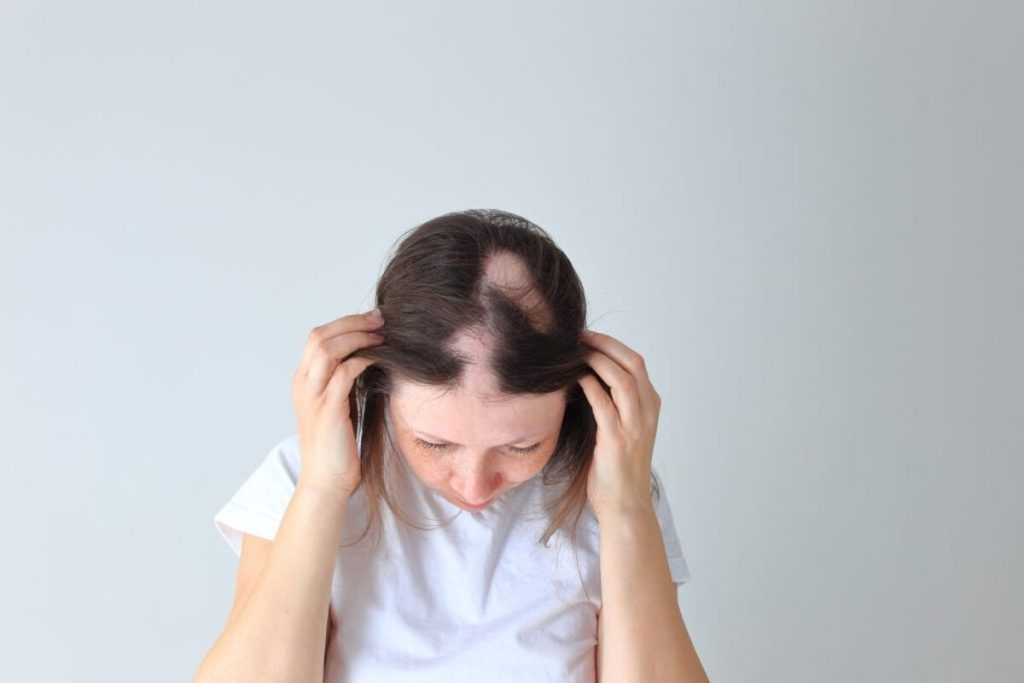blog, Health, Immunity, Skin health
What is Alopecia? Causes and Treatment of Alopecia
On average we lose about 50 to 100 strands of hair a day. However, we do not even notice it, since new strands of hair come out instead of the lost ones. If no new hair is formed and the amount of lost hair increases greatly, hair loss and opening on the scalp become obvious. Alopecia, is a form of hair loss that is easily noticed on the scalp. In this article, we have tried to answer the questions you might have about the possible causes and treatment of this disease.
Table of Contents
What is Alopecia?
Alopecia is an intense and rapid hair loss caused by the body’s immune cells attacking the hair follicles.
It is not an infectious disease. However, a genetic predisposition is one of the main causes of the disease and several people in the family can have it.
Hair loss can occur anywhere on the body:
- Eyelashes
- Eyebrows
- Body hair
Alopecia occurs due to various individual and environmental factors and autoimmune functions. So what is the autoimmune function?
In case of autoimmune disease, our immune cells sometimes perceive normal and healthy tissues as foreign. A healthy immune cell provides immunity against microbes such as bacteria and viruses. When autoimmune diseases occur, the immune cells begin to target tissues and organs such as;
- Skin
- Bones
- Muscles
In case of alopecia disease, skin cells attack the hair follicles which makes hair follicles stop growing hair in this area.
Causes of Alopecia
Although the cause of alopecia has not been fully determined yet, the following factors are thought to cause the disease:
- Genetics
- Hormonal disorders
- High level of stress
- Medications
- Autoimmunity
Apart from the above mentioned factors, the following factors also increase the risk of alopecia:
- Age (the incidence is higher in people under the age of 40)
- Sudden and excessive weight loss
- Malnutrition
- Stressful environments
- Other autoimmune diseases such as diabetes and lupus.
- Having another individual with alopecia in the family
What are the Symptoms of Alopecia?
Hair loss that begins on the scalp also manifests itself in other parts of the body.
- Eyelashes
- Eyebrows
- Armpits
- Beard
- Pubic area
The symptoms vary from individual to individual.
The following structural changes of finger and toenails can occur:
- Fragility
- Deformity
- Redness
- White spots
- The Loss of nail shine
The symptoms of hair loss vary from person to person and can include the following:
- Regional hair loss
- Loss of facial hair, such as eyebrows, eyelashes, beards
- Whole body hair loss
- Itching or painful sensations due to inflammation
- If the inflammation in the hair follicle decreases the hair can grow back. However sometimes the hair that grows back is nonpigmented (white)
How is Alopecia Diagnosed
A consultation with dermatologist is necessary to diagnose alopecia.
Hair loss can also be the result of vitamin deficiency, a symptom of another disease, or an indication of a so-called scalp fungus.
Your doctor will first inquire about your symptoms and check the degree of hair loss. If deemed necessary, a few hair strands will submitted to the pathology department for examination.
How is Alopecia Treated?
It is believed that the autoimmune problems like alopecia are mainly caused by stress and psychological disorder. Malnutrition is known to be one of the factors affecting psychological health and wellbeing.
In order to regulate their nutrition, individuals need to get to know their bodies. This can be done by evaluating the metabolic response to nutrition or getting a detailed microbiome analysis. Microbiome controls our metabolism, and by balancing our gut microbiome we can fine-tune the gut-brain axis and strengthen our immune system. And in order to balance our microbiome we need to know which nutrients are specific to our needs.
Drug therapy may be prescribed in severe cases, when nutrition does not work.
The primary objective of the alopecia treatment is to stop the progression of the disease and reduce the severity of symptoms.
Drugs such as diphenylcyclopropenone, squaric acid dibutylester, cortisone, cyclosporine, can be used. Some of these drugs are aimed at suppressing the immune system, since the disease occurs when the immune cells attack the hair follicles.
Cortisone-containing drugs are also used to treat alopecia. These drugs suppress the immune system as well. It can be administered via injection or as ointment. Unlike other drugs, you need to pay special attention to your diet when taking cortisone, since cortisone-containing drugs can cause edema and weight gain.
Small Changes Can Help Keeping Disease Under Control
In addition to medication, making the following small changes to your daily routine and life style can also help keeping the disease under control:
- Quit smoking
- Protect your scalp from sun exposure
- Choose your hair products carefully
- Pay attention to your eating habits
Foods we consume affect alopecia, as well as many other diseases.
Our metabolism, immune system, disease predisposition vary from person to person. Therefore, our food choices should also be based on specific needs of our microbiome.
Our microbiome helps us control our immune system, skin health, and metabolism of the nutrients we consume.
As long as the trillions of bacteria on our skin, intestines, mouth and nose are well-balanced, the risk of developing alopecia is low. Alopecia is an autoimmune disease caused by our immune system, and our immune system is regulated by trillions of bacteria in our microbiome.
Get to know your microbiome and balance it with the nutrients that ENBIOSIS has identified specifically for you.
With ENBIOSIS test kit sent to you, you can collect sample in the comfort of your home. Using the prepaid envelope you will then ship the sample to our laboratory. The laboratory will then conduct a detailed AI-powered microbiome analysis.
After profiling the bacteria in your microbiome, a personalized nutrition guide is generated and sent to your address along with your personalized prebiotic.
Upon receiving your analysis results, you will start your individual 6 weeks long nutrition program. During your weekly online consultations, your dietitian will inquire about your daily routine and dietary preferences, review and explain your analysis results, and design a personalized diet plan that will be renewed every week.
Frequently Asked Questions About Alopecia
We have compiled some of the most frequently asked questions about alopecia:
-
Can Alopecia be Cured?
There are currently no treatments that work for everyone with alopecia. Treatment depends on the variety of symptoms shown by the individual, the age of the patient and the intensity of hair loss.
-
What is the Relationship Between Alocepia and Microbiome?
These are some of the factors that can cause alopecia:
- Poor nutrition,
- Weakened immune system,
- Impaired skin microbiome
- Various medication
- Poor quality care products,
- Exposure to ultraviolet light
In addition to causing alopecia, these conditions also deteriorate the microbiome.
Modulating microbiome with nutrition has been shown to improve alopecia as well.
Thus, it can be said that there is a direct link between the health of the microbiome and a risk of developing alopecia.
-
Can Alocepia be Cured With Any Specific Food?
The course of the disease varies from individual to individual. That is why it would be wrong to suggest a single nutrient as a nutritional recommendation.
-
Is Garlic Good for Alocepia?
It has been proven that garlic has positive effect on hair. However, although it improves the symptoms of alopecia it cannot cure it completely
-
How Long Does it take to treat Alopecia?
According to recent studies, 20-30% of people with alopecia worldwide recover completely on their own in a short time. However, the duration of the disease varies from person to person.


 العربية
العربية Русский
Русский Português
Português 中文 (中国)
中文 (中国) Türkçe
Türkçe Spanish
Spanish Polski
Polski

